Types of Texas Spiders (With Pictures) – Identification Guide
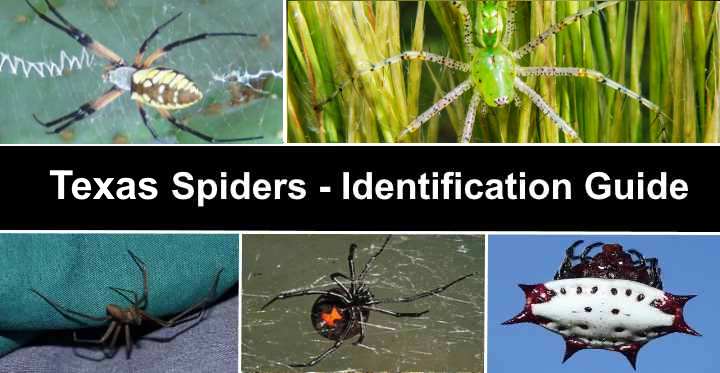
Texas is home to many kinds of spiders — some people reckon over 100 arachnoid species. From Amarillo in the panhandle to Corpus Christi and east to Dallas and Houston, you will find many types of brown spiders, the common Texas wolf spider, and several species of black and white spiders. Although there are a few varieties of venomous spiders in Texas, most spiders are relatively harmless.
Knowing how to identify spiders in Texas is helpful if you live there or are visiting the Lone Star State. The hot climate and warm winters in Texas mean that seeing these eight-legged creepy crawlies is relatively common. And it’s crucial to tell the difference between biting, venomous spiders and those that won’t harm you.
Has a scurrying brown spider startled you as it darted across the floor, and you want to know its type? Or, do you want to know which are the most dangerous Texas spiders? If so, this article has descriptions, pictures, and identification features of the most common spiders in Texas.
What are the Most Common Spiders in Texas
The most common spiders in Texas are funnel weaver grass spiders, orb weaver spiders, the brown Texas recluse, and the Carolina wolf spider. You will usually find these brown and colorful spiders outdoors lurking in dark places, under logs, debris, or stones. These spiders typically only come indoors when the weather cools.
What are the Most Common House Spiders in Texas
The most common spiders you’ll find in undisturbed places indoors in Texas are the common house spider, Texas brown widow, cellar spiders, and the southern house spider. Of the common house spiders, the most venomous ones in Texas are the brown recluse and the brown widow.
How to Identify Texas Spiders
The identifying features of spiders in Texas are their body shape and size, distinctive markings, and if they appear furry or not. For example, the brown recluse and brown widow spider may look similar. However, the brown widow has a distinctive hourglass marking. In contrast, the black and white jumping spider has a hairy body.
As with all species of spiders, Texas spiders are arthropods in the class Arachnida. They are identified by their eight jointed legs, a two-segmented body consisting of an abdomen and cephalothorax, and visible mouthparts (chelicerae). In addition, spiders lack antennae and wings, which are common in most insect species.
When giving measurements of spiders, the sizes are usually only for the length of the spider’s body. However, some Texas spiders may appear much larger and menacing because they have a considerable leg span.
Types of Spiders Found in Texas (With Pictures) – Identification Guide
Let’s look in detail at the identifying features of the most common Texas spiders you are likely to find in the house, yard, or outbuilding.
Brown Recluse Spider (Loxosceles reclusa)
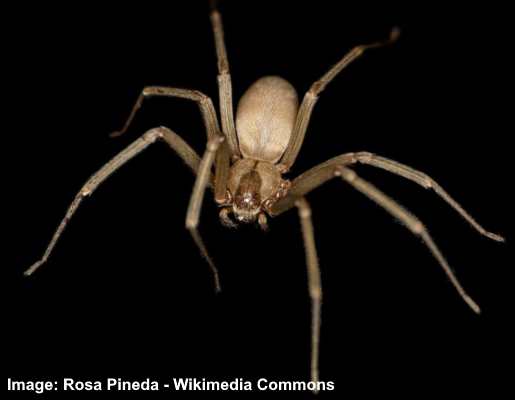
Brown Recluse Spider (Loxosceles reclusa)
The brown recluse is a venomous brown spider commonly found indoors in Texas. The brown recluse spider is recognizable by its violin pattern on the cephalothorax. Other identifying features are light to medium brown body, long jointed legs, and six eyes. Sometimes, this venomous Texas spider can look dark brown to blackish gray.
The brown recluse measures 0.25” to 0.5” (6 – 12 mm) long. Native to Texas, this tan to light-brown colored arachnoid can be identified indoors by its messy, irregular webs in dark, dry, undisturbed places. Therefore, they are common in closets, basements, attics, and boxes. Despite the brown spider biting, it typically scurries away when disturbed.
A brown recluse spider bite can cause localized swelling, redness, and pain.
Texas spider identification: The brown recluse spider has a light to dark brown body, six eyes, and long, outstretched legs. Its distinctive marking is the violin shape on its dorsal size of the cephalothorax.
Texas Recluse Spider (Loxosceles devia)
The Texas recluse is a type of brown spider common throughout the Lone Star State. This native spider has long, translucent brown legs and a bulbous chocolate-colored body. Like the related brown recluse, this Texas spider has fiddle-shaped markings near its head. Also known as a violin spider or fiddle-back spider, the arachnoid measures 0.3” (9.5 mm) long.
Texas Brown Tarantula (Aphonopelma hentzi)
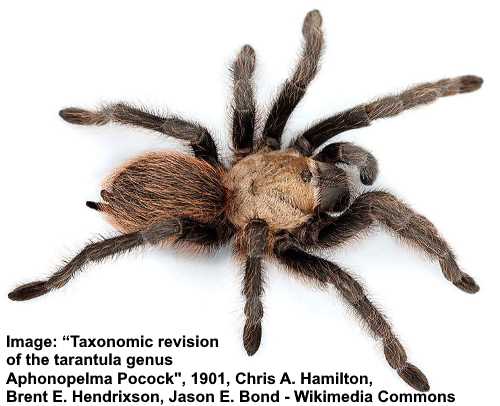
Texas Brown Tarantula (Aphonopelma hentzi)
The Texas brown tarantula is one of the most common hairy brown spiders in the southern states. The huge fuzzy spider has a brown, bulbous body and thick, stout pale brown or black legs. However, identifying these brown tarantulas can be tricky because there is variation in the coloring.
The Texas brown tarantula females grow between 2” and 2.25” (50 – 57 mm) and have a leg span double that size. Pictures of the Texas brown tarantula show that they are as large as the palm of your hand.
You can find these furry brown spiders in Texas, where they live in burrows, under logs, or in grasslands. Although they have large fangs and can puncture the skin with their bite, they don’t usually inflict severe damage.
Texas spider identification: The Texas brown tarantula has a hairy brown body, eight tan or black hairy legs, and a pair of fangs.
Brown Spitting Spider (Scytodes fusca)
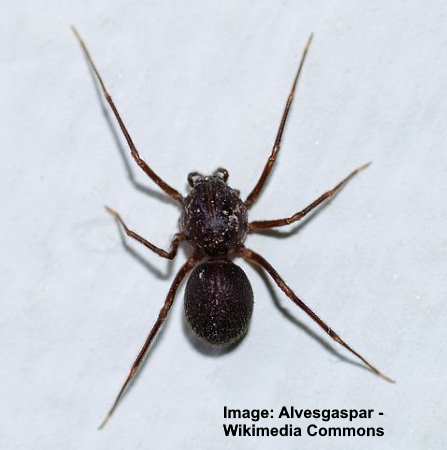
Brown Spitting Spider (Scytodes fusca). The female spider in the picture has lost its front legs
The brown spitting spider is an easily recognizable Texas spider due to its black, rounded abdomen, creamy-white to tan patterns, and long spindly legs. In addition, this common spider has six eyes, which is relatively uncommon among arachnoids. Its bulbous body and the cephalothorax measure 0.2” to 0.23” (5 – 6 mm).
Brown spitting spiders get their name from their habit of expelling a gum-like substance from their mouths to trap their prey. Although you can find them indoors in Texas, they are usually found in fields, under loose bark, or living in hollowed tree trunks.
Texas spider identification: The spitting spider is identified by its dark-colored abdomen, long legs, and six eyes. Some species have identifiable patterns on their back, whereas others are just plain brown or black.
Huntsman Spider (Heteropoda venatoria)
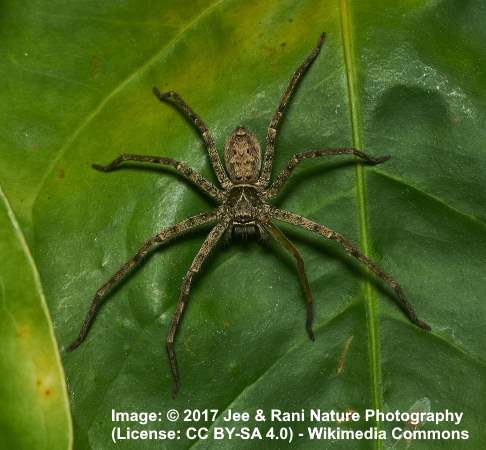
Huntsman Spider (Heteropoda venatoria)
The huntsman spider has a flat, oval light to dark brown body and dark blackish-gray mottled patterns. Because of its size and coloration, it’s easy to mistake the huntsman spider for a brown recluse. However, this dark-colored Texas spider has a larger body and leg span.
The huntsman spider can grow up to 1” (25 mm). However, its enormous leg span of 4” (100 mm) makes it look like one of the largest spiders in Texas. Other identifying marks of this spider are its white and black spots on long furry legs.
You will commonly find the huntsman spider indoors because of its intolerance to cold. However, in Southern Texas, you may discover the huntsman spider outdoors in the yard throughout the year.
Texas spider identification: The large huntsman spider is identified by its light to dark brown flattened body, grayish-brown mottled patterns, and slightly spiny hairy brownish body. It also has eight black eyes set in two rows.
Black and White Bold Jumping Spider (Phidippus audax)
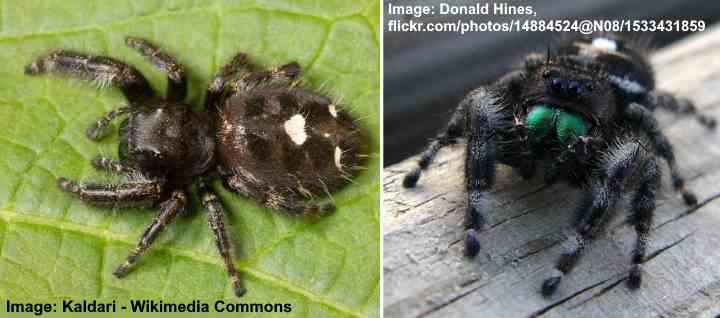
Bold Jumping Spider (Phidippus audax)
The bold jumping spider is a type of fuzzy Texas spider with a black body and a white heart-shaped mark on its abdomen. To distinguish this jumping spider from others, look for its fuzzy black legs and unusual chelicerae with an iridescent green color. Fine setae also cover its black body.
The bold jumping spider is a black and white Texas spider that measures 0.15” to 0.7” (4 – 18 mm) long, making it one of the smallest hairy spiders in Texas. Also called the white-spotted jumping spider, you will often find the spider outdoors in open areas in your yard.
This black and white spider pounces on prey rather than spinning webs to catch its food.
Texas spider identification: The bold jumping spider is easy to identify in Texan landscapes due to its fuzzy black body, white spots on its abdomen, and large cephalothorax.
Long-Bodied Cellar Spider (Pholcus phalangioides)
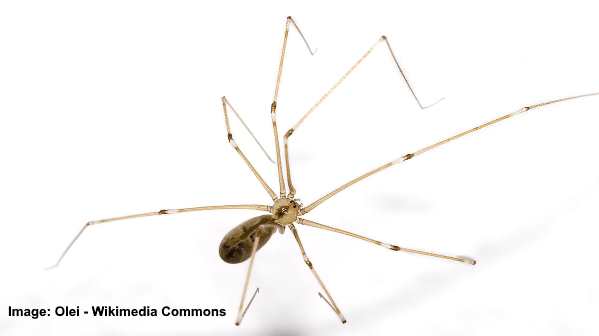
Long-Bodied Cellar Spider (Pholcus phalangioides)
Long-bodied cellar spiders are harmless brown house spiders common throughout Texas. The easy-to-identify spider has long, thin legs attached to a tear-shaped, slender brown body. Despite its small size, the huge leg span makes the yellowish-brown spider species appear much larger. These indoor spiders are also called daddy long-leg spiders or skull spiders.
Long-bodied cellar spiders grow up to 0.8” (20 mm) long. However, their leg span is five or six times this size, measuring up to 2.75” (70 mm).
As their common name suggests, these predatory spiders are found in dark, dimly-lit corners of homes like cellars, attics, garages, or the corners of ceilings.
Texas spider identification: The long-bodied cellar spider is easy to spot due to its brown oval body and long spindly, arched legs.
Gray Wall Jumping Spider (Menemerus bivittatus)
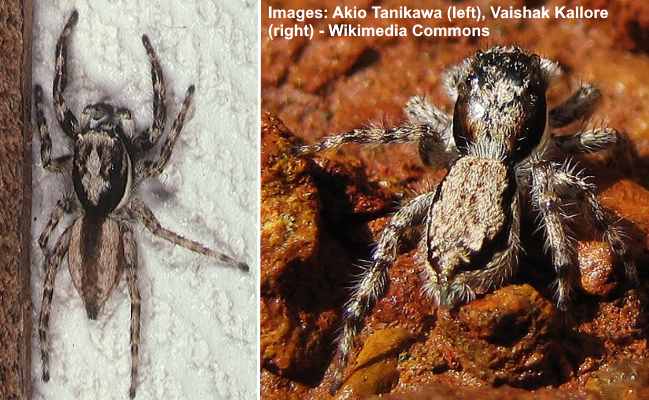
Gray Wall Jumping Spider (Menemerus bivittatus). In the picture: male (left) and female (right)
The gray wall jumping spider is a black and gray hairy spider found in southern states like Florida, Texas, and California. The small Texas spider has a pale gray-brown body with marginal black bands. In addition, the hairy legs have several black stripes around them.
These spiders’ appearance differs between males and females, with the males looking darker and having smaller bodies. The gray wall jumping spider grows up to 0.39” (10 mm). In Texas, you will often find the gray wall jumping spider on tree trunks or attached to the walls of buildings — hence the name.
Spiders in this common Texas spider species are classified as beneficial arachnoids. The harmless gray spider preys on flies, mosquitos, and other common human pests. Additionally, they don’t create webs, meaning they are not annoying, messy indoor spiders.
Texas spider identification: The gray wall jumping spider is identified by its flattened body, dark color, and distinctive white and gray-colored markings. This spider species also has distinctive gray, black-banded legs and prominent carapace.
Pantropical Jumper Spider (Plexippus paykulli)
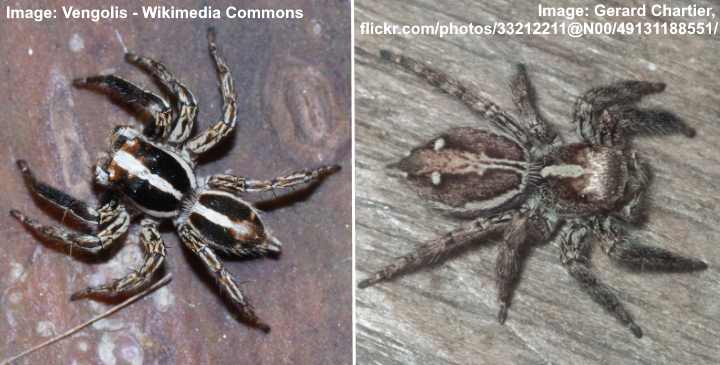
Pantropical Jumper Spider (Plexippus paykulli). This image: male (left) and female (right)
The pantropical jumper is a Texas spider with prominent black and white stripes. This fuzzy spider is primarily black, with a white line running longitudinally down its center. The females tend to be dark gray with less distinctive markings. The females also have two distinctive whitish markings near the spinnerets.
The Texan pantropical jumper spider measures 0.35” to 0.43” (9 to 11 mm). As with many spider species, there is a noticeable difference between the male and female species.
Like the related gray wall jumping spider, you will often find this spider on the outside of buildings. This type of hunting spider captures its prey by stealth and then jumps on them.
Texas spider identification: The pantropical jumping spider has a recognizable light-colored stripe down its center and is covered in gray to black hairs.
Texas Wolf Spider (Rabidosa rabida)
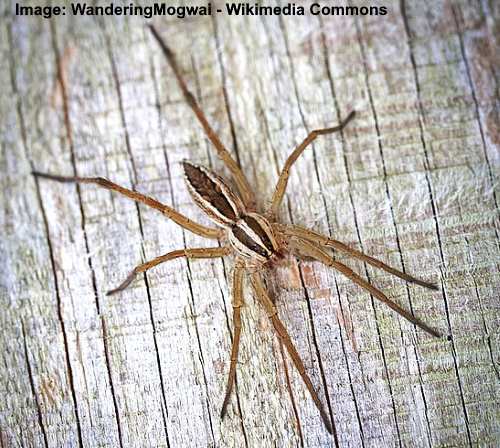
Texas Wolf Spider (Rabidosa rabida)
Also called the rabid wolf spider, the dark brown spider with white stripes is sometimes found in Texan homes. Identifying features of the spider are long, slender brown legs, three white stripes on its cephalothorax, two marginal stripes on its dark brown abdomen and small beige spots.
The brown Texas wolf spider is 1” (25 mm) long and is found throughout the State. You will usually encounter the Texas wolf spider in wooded areas, cotton fields, or in garbage. Although the brown spider can bite, it only does so when provoked, and its bite is harmless.
Texas spider identification: The Texas wolf spider is a dark brown spider with identifiable white stripes on its head and abdomen. The large hunting spider has eight long legs and eight eyes in two rows of four.
Common House Spider (Parasteatoda tepidariorum)
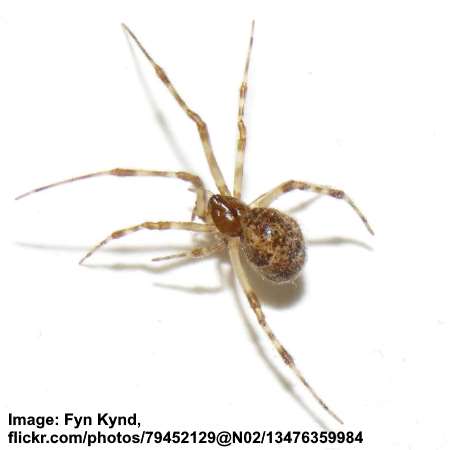
Common House Spider (Parasteatoda tepidariorum)
The common house spider is a small indoor spider with a tan to brown bulging, bulbous body with mottled patterns and pale, banded legs. Commonly known as the American house spider, this brown spider is found throughout Texas.
A trait of common house spiders is making cobwebs to catch their prey. The small spiders measure 0.20” to 0.24” (5 – 6 mm) and are difficult to spot due to their body patterns. However, their extensive leg span allows the common indoor spiders to measure over 1” (25 cm) wide.
Although house spiders are classified as venomous, they are not dangerous to humans.
Texas spider identification: Identifying features of the common house spider are its rounded body covered in whitish, brown, and tan pigments and dark lines running down its sides.
Southern House Spider (Kukulcania hibernalis)
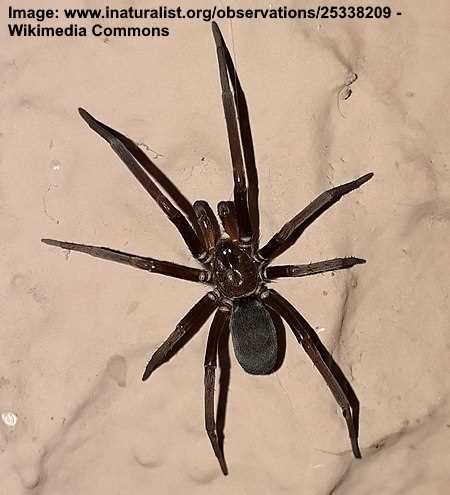
Southern House Spider (Kukulcania hibernalis)
The southern house spider is common throughout Texas in populated areas. The large southern house spider is a charcoal gray to dark brown color with an elongated abdomen, large, tapered legs, and eight eyes. An identifiable feature of this brown spider is its two large appendages protruding near its mouth.
The southern house spider grows 0.51” to 0.74” (13 – 19 mm) long. Some species have a recognizable violin marking on their head, although not as noticeable as the brown recluse.
Like many types of brown house spiders, the southern house spider is relatively solitary and prefers lurking in sheltered, dark recesses. You will often find the brown spiders in attics, basements, and corners of window sills. They are also known for building tangled, unkempt webs. However, these messy webs are ideal for controlling house pests like flies, cockroaches, beetles, and mud daubers.
Texas spider identification: The southern house spider has an identifiable slender dark brown or black body, a fuzzy appearance, and long legs. These common Texas spiders are easy to mistake for a brown recluse.
American Nursery Web Spider (Pisaurina mira)
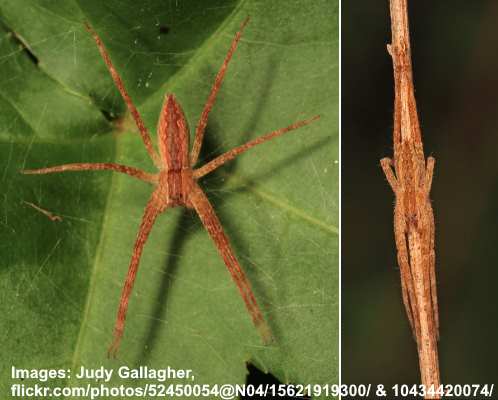
American Nursery Web Spider (Pisaurina mira). Right image: the spider is camouflaged like a stick
The American nursery web spider has a long, slender abdomen that tapers to a point at its spinnerets. Pictures of this orange-brown spider show it resting with its long front two legs together, making it appear as if it has six legs. An unusual feature is its eight black eyes — four in a straight row and four in a curved row forming a U shape.
The American nursery web spiders measure 0.47” to 0.74” (12 to 15 mm) long. However, its long, straight legs make it appear significantly larger. You will likely come across these brown spiders in woods, meadows, fields, shrubs, and bushes. They are common from the Rio Grande Valley of Texas to Central Florida.
Texas spider identification: The American nursery web spider is identified by its rusty brown color, slender body, and long tapering legs.
Banana Spider (Nephila clavipes)
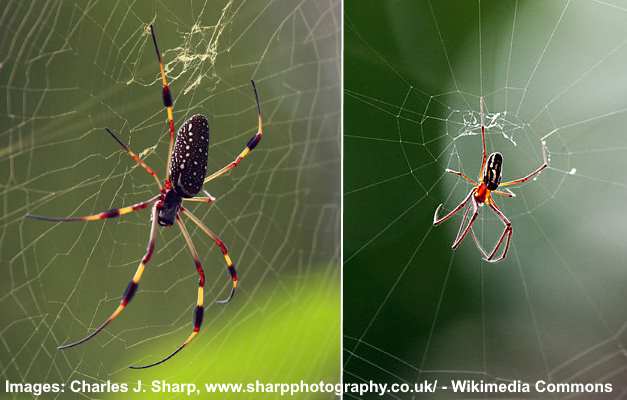
Banana Spider (Nephila clavipes): female (left) and male (right)
The banana spider is a brightly-colored Texas spider with a striking dark brown body with creamy-white speckles. As the spider matures, its abdomen changes color — from bright orange to reddish-brown and rows of yellowish dots. The banana spider also has yellow legs with dark brown bands on them.
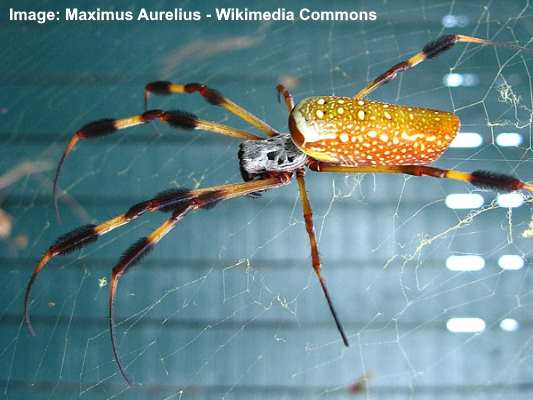
Mature female Banana Spider
The banana spider is a type of orb weaver that also goes by the names golden silk spider, calico spider, giant wood spider, or golden silk orb-weaver. The large, slender colorful spider measures 0.94” to 1.57” (24 – 40 mm).
Banana spiders are common in warm climates from North Carolina through the Gulf States. They are primarily found in gardens, where they spin elaborate webs to catch prey. Due to their large, yellowish appearance, banana spiders are sometimes confused with black and yellow garden spiders.
Banana spiders are considered to be the largest orb-weaver native to Texas.
Texas spider identification: The banana spider has a brightly-colored spotted cylindrical abdomen with a relatively small head. Their coloring ranges from rusty reddish-brown to bright yellow with white spots.
Black and White Spinybacked Orb-Weaver (Gasteracantha cancriformis)
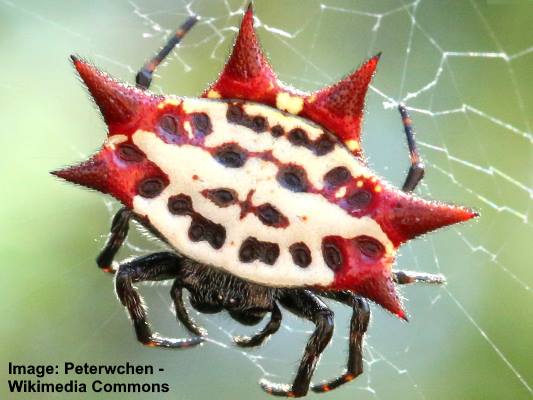
Black and White Spinybacked Orb-Weaver (Gasteracantha cancriformis)
The spiny-backed orb-weaver is one of the most unusual black and white spiders you’ll find in Texas. Its easily identifiable features are a black head and legs and black spots on its white abdomen with its characteristic six red fleshy spins around its margin. The white, uniquely-shaped abdomen is broader than it is long.
The tiny outdoor spiders measure 0.2” to 0.35” (5 – 9 mm) long and up to 0.51” (13 mm) wide. The scientific name of this black and white spider comes from its crab-like form. However, its common name comes from its distinctive black or red projections on its abdomen and the attractive orb-shaped webs they spin.
Identifying the spinybacked orb-weaver can be tricky. First, the spider is tiny and lives in shrubby gardens or woodlands. Also, the coloring can change; sometimes, the spider has black spines, and other times it has a yellow, orange, or red abdomen and black dots. However, this striking spider has a distinctive appearance compared to other spiders.

Color variations of the spinyback orb-weaver spider
The native orb-weaving black and white spider is common in southern and eastern Texas.
Texas spider identification: The spinybacked orb-weaver is identified by its crab-like appearance and has a smooth white abdomen covered in black spots. There are also six distinctive black or red pyramidal projections around its oval abdomen.
Southern Black Widow Spider (Latrodectus mactans)

Southern Black Widow Spider (Latrodectus mactans)
The southern black widow spider is a venomous Texas spider. The black spider, with its shiny black bulbous abdomen, black legs, and tiny head, has a characteristic red hourglass marking on its underside. Sometimes, there is a recognizable red spot on top of the abdomen at the tail end.
This black and red spider measures 0.31” to 0.51 (8 – 13 mm) long, with males half the size of the females. The native range of the southern black widow is from Texas to California and north to Ohio. Black widows are often found in undisturbed, dark places like under logs, barns, attics, furniture, or in crevices.
You can typically notice black widow spider activity by the messy webs they spin, usually placed near the ground.
Southern black widow spiders typically only bite when threatened or disturbed. Although the female spiders can inflict a nasty bite, they are rarely harmful to humans.
Texas spider identification: The southern black widow spider is easy to identify due to its ball-like abdomen, shiny black color, and red hourglass marking.
Texas Brown Widow Spider (Latrodectus geometricus)
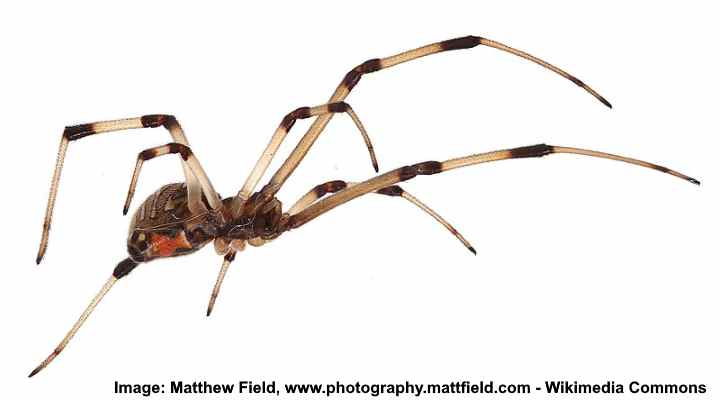
Texas Brown Widow Spider (Latrodectus geometricus)
The Texas brown widow spider is a venomous spider native to Texas. The distinctive characteristics of this spider are its brown body, brightly colored orange hourglass marking, and long banded legs. In addition, the brown spider has a brown and white geometric pattern on its abdomen’s dorsal side.
Also called geometric brown widow, gray spider, or house button spider, the Texas brown widow measures 0.27” to 0.39” (7 – 10 mm), making it smaller than typical black widow spiders. As with most spider species, the males are significantly smaller.
The brown widow spider is common throughout the southern states of the US, including Texas. They tend to lurk in dark, secluded places like under the eaves of buildings, in tree hollows, and under garden debris. However, you will also find them in brighter areas like the corners of windows and on top of fences.
An identifying feature of brown widow spider activity is their recognizable creamy-white spiky egg sacs.
Texas spider identification: The Texas brown widow is easy to spot due to its dark brown color with vivid orange hourglass marking on its underside. Distinctive features include tan legs, dark brown stripes, and geometric patterns on its abdomen.
Yellow Garden Spider (Argiope aurantia)
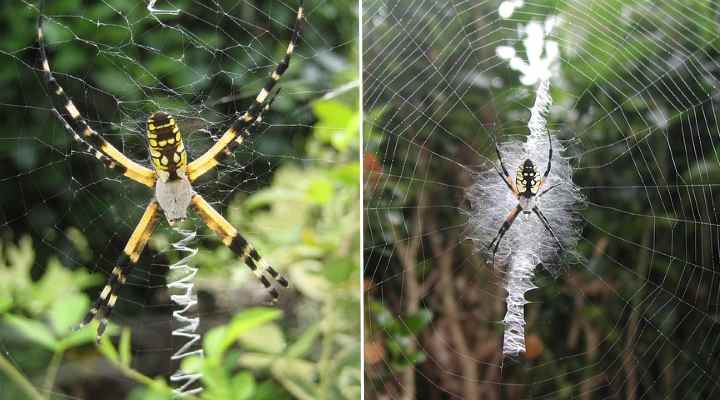
Black and Yellow Garden Orb-Weaver (Argiope aurantia)
The yellow garden spider is one of the most striking yellow spiders you’ll find in Texas yards. The large golden yellow and black spider has a whitish cephalothorax, yellow legs with black bands, and yellow spots on a black abdomen. The large garden spider measures 0.57” to 1.1” (19 – 28 mm).
Common in Texas garden landscapes, the yellow garden spider is venomous. However, it’s not an aggressive black and yellow spider — it only bites when threatened. It will mostly scurry away when disturbed. However, its bite can be as painful as a bumblebee sting.
Also called the zigzag spider, writing spider, or corn spider, the distinctive feature of this spider’s behavior is its eye-catching webs with a characteristic white zigzag pattern. In addition, when resting on the web, the spider has a distinctive ‘X’ shape when it puts its two front legs and two back legs together.
Texas spider identification: The yellow garden spider has a black oval, pointed abdomen with distinctive yellow and gray markings, tan to dark brown black-banded legs, and a whitish-gray cephalothorax.
Arabesque Orb-Weaver Spider (Neoscona arabesca)
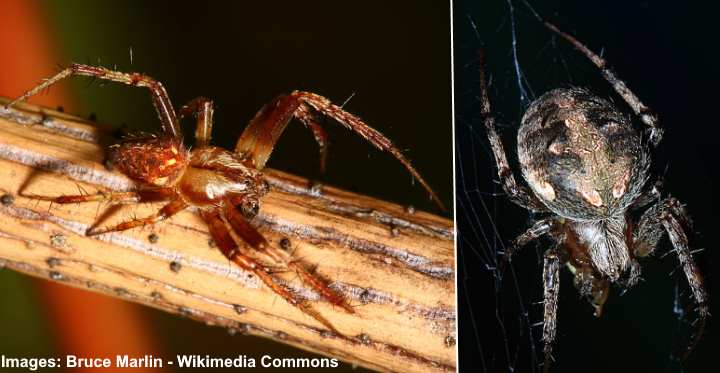
Arabesque Orb-Weaver Spider (Neoscona arabesca): male (left) and female (right)
The arabesque orb-weaver spider is a brightly colored, non-aggressive spider common in Texas yards. The small spider has distinctive patterning on its abdomen. The female orb-weavers are dark brown to black with an oval abdomen and spiny legs. The males are slenderer and have a rusty brown color.
The arabesque orb-weaver measures 0.2” to 0.28” (5 – 7 mm), with the males slightly smaller. This spider species is one of the most common orb-weavers in the United States. You will often find the spiders in garden landscapes spinning webs on ornamental flowering bushes and shrubs. The brown male spiders commonly hunt their prey at ground level.
Texas spider identification: The arabesque orb-weaver is identified by its dark, rounded abdomen with ornate patterns consisting of curvy dashes and short lines. These patterns are unique to this orb-weaver species.
Dark Fishing Spider (Dolomedes tenebrosus)
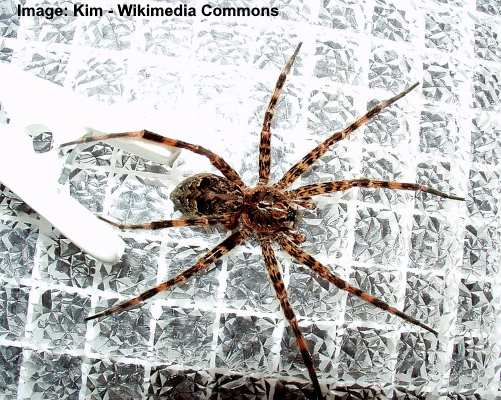
Dark Fishing Spider (Dolomedes tenebrosus)
The dark fishing spider is a large dark brown spider with lighter chevron markings and stripes on its body and legs. The spider is identified by its oval to tear-shaped abdomen, large brownish gray head, and prominent chelicerae. This large brown or black spider species measures 0.59” to 1.02” (15–26 mm), and the males are half that size.
The dark fishing spider looks like a wolf spider in size and color. This species gets its name because it tends to live near water and even hunts for aquatic insects as they walk on water. However, they are commonly found in trees and often make their way into homes.
Some noticeable features of these large furry spiders are their huge size and their brown and rusty or orangey-red patterns. In addition, their exceedingly long legs give them an overall leg span of up to 3.5” (90 mm).
The dark fishing spider looks similar to the related striped fishing spider (Dolomedes scriptus). The differences between these two brown spiders are that the striped species is a lighter brown, with more white coloration and prominent stripes.
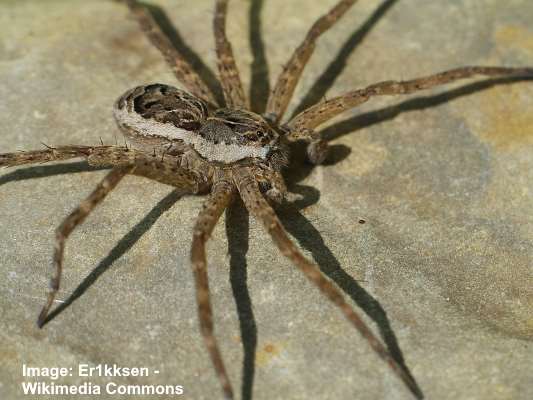
Striped fishing spider (Dolomedes scriptus)
Texas spider identification: The dark fishing spider is common in Texas and is identified by its brownish-gray color with light brown and black markings. The spider’s legs are hairy with alternating bands of reddish-brown and black colors.
Carolina Wolf Spider (Hogna carolinensis)
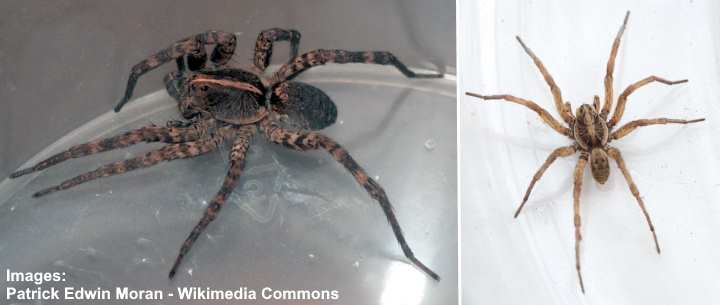
Carolina Wolf Spider (Hogna carolinensis): female (left) and immature male (right)
The Carolina wolf spider is a large hunting spider found in the State of Texas. The females are black with a large bulbous abdomen, black cephalothorax with an orange central stripe, and long banded legs. This is the largest species of wolf spider in North America, and the furry spider measures around 2” (25 mm) long.
As with many species of spiders in Texas, there are color variations between the males and females. Male Carolina wolf spiders tend to be light brown with tan-colored legs and a lighter stripe on their cephalothorax. Additionally, you’ll notice that the abdomen is significantly smaller than its head.
The behavior of the Carolina wolf spider is hunting rather than web spinning. The spiders live in small burrows waiting to ambush their prey — small insects or invertebrates. Occasionally, they will make their way into homes. Although the dark brown spider is venomous, it doesn’t bite humans. Instead, it uses its venom to catch and kill common house pests like cockroaches and other bugs.
Texas spider identification: The Carolina wolf spider is a large, harmless spider with a furry, dark brown body, orange stripe on its head, and mottled or banded legs.
American Grass Spider (Agelenopsis naevia)
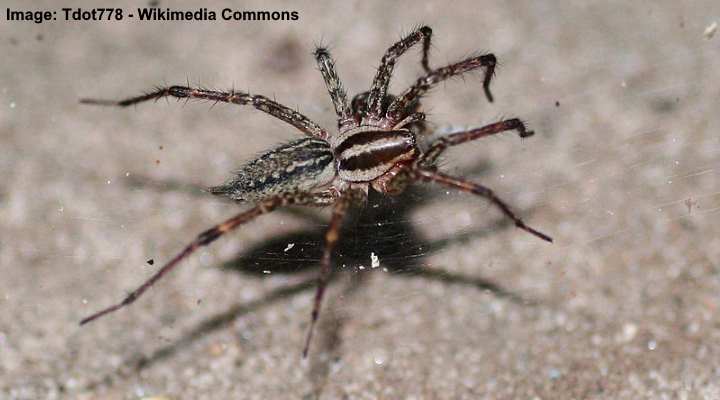
American Grass Spider (Agelenopsis naevia)
The American grass spider is a harmless spider in Texas with an identifiable brown head, three white stripes, and a grayish abdomen with mottled patterns. The characteristics of the American grass spider are its eight eyes set in three rows, its ability to spin funnel-like webs, and its incredible running ability.
The American grass spider grows up to 0.75” (19 mm) long. As a species of grass spider, the arachnoid is often found scurrying in yards chasing after its prey. However, the brownish, white-striped spider usually stays in the funnel end of its non-sticky web.
In Texas, it’s easy to confuse this common grass spider with the American nursery web spider or wolf spider.
Texas spider identification: To identify the American grass spider, look for the three whitish bands on its brown cephalothorax, indistinct bands on its grayish abdomen, and brown spiny legs.
Green Lynx Spider (Peucetia viridans)

Green Lynx Spider (Peucetia viridans)
The green lynx spider is a tropical garden spider found in Texas landscapes. The conspicuous green spider has a lime green body, a slender tapering abdomen, six chevron brown marks, and a few brown-reddish spots. The distinct green Texas spider has pale white, almost translucent legs with long black spines.
The female green lynx spider measures 0.87” (22 mm) long, with the males over half their size. Although green is its dominant color, the spider can change to having a pale yellow abdomen with streaks of red.
The brightly colored green spider is typically found in garden landscapes. Its keen eyesight allows it to hunt its prey rather than using webs. If you see this unusual green spider in your yard, you will recognize it by its darting movements.
Texas spider identification: The green lynx spider is easily distinguishable from other garden spiders due to its bright green body, reddish dots, brownish abdominal markings, and pale green to yellow legs with numerous black spines. The pale-yellow legs also have black spots.
Trapdoor Spider (Ctenizidae ummidia)
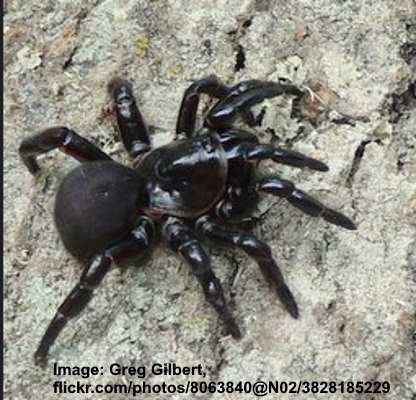
Trapdoor Spider (Ctenizidae ummidia)
The trapdoor spider is a stout, black spider with a bulging bulbous abdomen, shiny black legs, and two prominent chelicerae. Pictures of these black spiders in Texas show they look like small tarantulas. The garden spiders measure 0.59” to 0.70” (15 – 18 mm) long and live in burrows in the ground.
These black furry spiders get their name from their distinctive habit of creating a cork-like closure to their burrows. The small black arachnoids wait for prey to come along and then ambush the tiny insects.
Texas spider identification: The black trapdoor spider is identified by its jet-black furry abdomen and shiny black spiny legs.
Tropical Orb-Weaver (Eriophora ravilla)
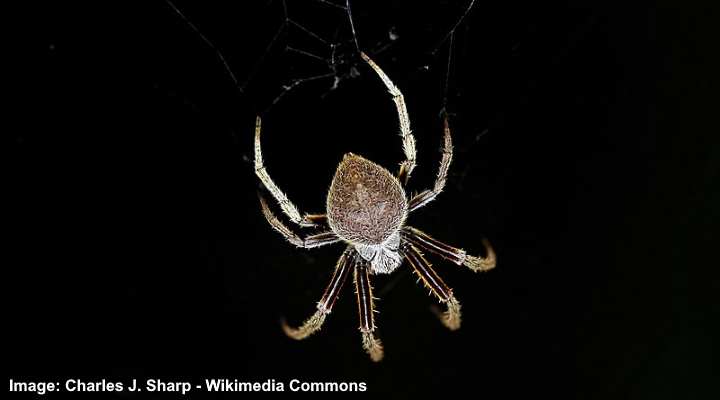
Tropical Orb-Weaver (Eriophora ravilla)
The tropical orb-weaver is a brown, furry spider covered in whitish-tan hairs. This Texas spider’s distinctive characteristics are its heart-shaped abdomen, slender reddish-brown cephalothorax, and dark-colored legs. These relatively large orb-weavers measure 0.47” to 0.94” (12 – 24 mm), with males half that size.
It can be tricky to identify tropical orb-weavers correctly because they have many color variations. For example, some dark brown specimens have a covering of fine, white setae. However, other species have white patches or a white stripe on their rounded abdomens. But all tropical weavers have significantly larger abdomens than their heads.
Texas spider identification: The tropical orb-weaver is a large reddish-brown fuzzy spider with a rounded, oval abdomen and a small head.
Humpbacked Orb-Weaver (Eustala anastera)
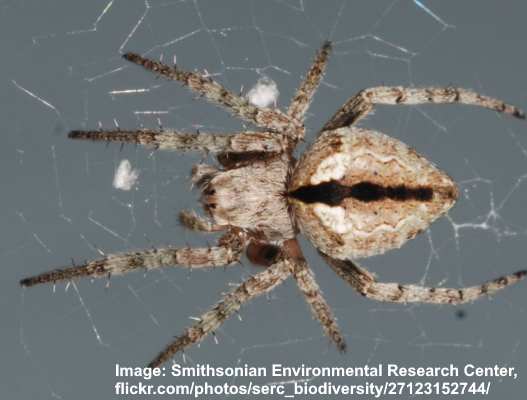
Humpbacked Orb-Weaver (Eustala anastera)
The humpbacked orb-weaver is a tan to light-brown spider, identified by its triangular-shaped abdomen with a prominent black central stripe. Like most orb-weavers, this harmless spider is covered in fine setae, giving the tiny spider a furry appearance. In addition, it has scalloped lines, a mottled appearance, and two white spots on its back.
The adult females measure 0.19” to 0.39” (5 to 10 mm) long. The humpbacked orb-weaver is a nocturnal spider often found in marshes, fields, and pine forests. The spider gets its name from its characteristic two or three humps on the backs of females.
Texas spider identification: The humpbacked orb-weaver is easy to identify due to its triangular-shaped abdomen that is widest at the cephalothorax and pointed at the rear. A broad black band in the center of the tan-colored abdomen makes it stand out amongst other orb-weavers.
White-Banded Crab Spider (Misumenoides formosipes)
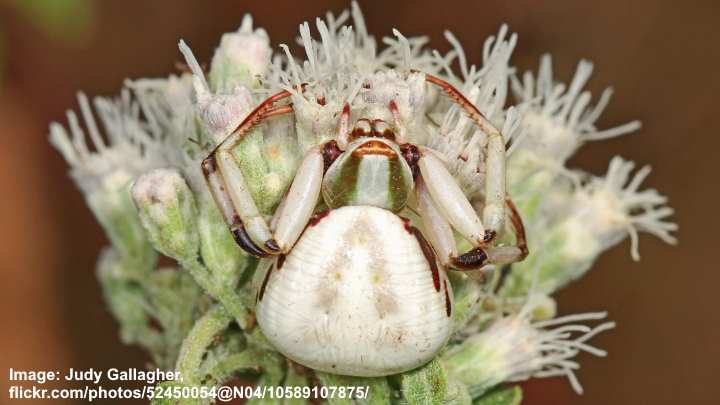
White-Banded Crab Spider (Misumenoides formosipes)
The white-banded crab spider is an unusual Texas spider due to its white coloring and crab-like appearance. The identifiable features of this crab spider are its rounded triangular abdomen, white and brown legs, and white band in the center of its head. These small spiders measure 0.2” to 0.44” (5 – 11 mm).
A distinctive feature of white crab spiders is that they can change their body color. Although white is the most common color, they can also be light brown or yellow, depending on the color of flower they are feeding on. In addition, their body markings can be black, red, or brown.
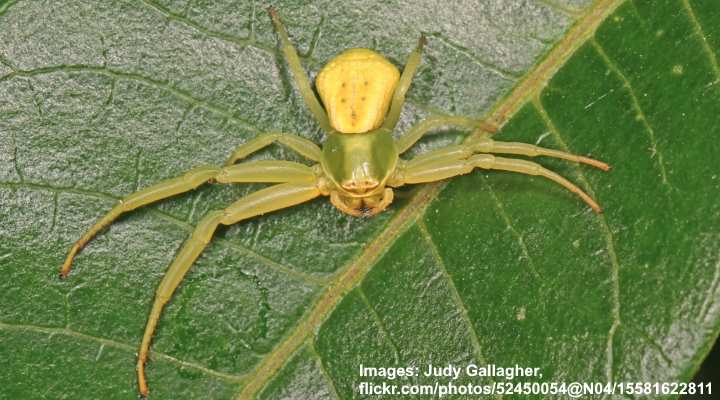
Yellow Misumenoides formosipes
Texas spider identification: The white-banded crab spider is easy to recognize due to its white color and resemblance to a crab in its body shape and positioning of the front legs.
Discover many common bugs and insects that can be found in Texas.
Related articles:
